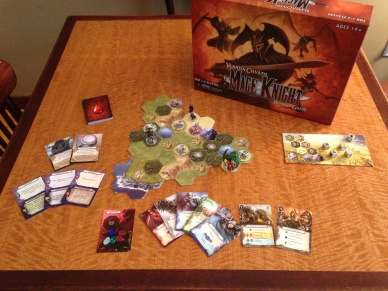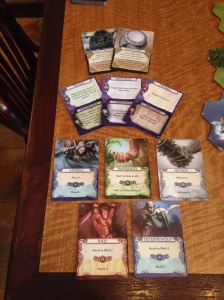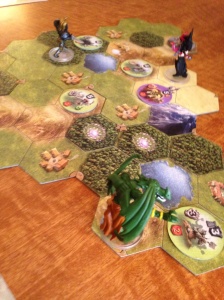So, what’s the deal with Mage Knight?
You are a powerful mage knight, sent through a portal with a specific mission – to conquer the cities in this distant land at any cost. Travel across the land, collecting resources and gathering power as you go by defeating enemies, conquering keeps and mage towers, and coercing minions to follow you. With the right determination and smart use of your skills, you’ll be powerful enough to take down even the grandest of cities.
What makes Mage Knight special?
Mage Knight has been my favorite game since it was released back in 2011. It evokes the feeling of an epic journey very well. The way in which characters grow in power in small and subtle ways throughout the game is very satisfying, as you go from being challenged by a lowly orc at the beginning of the game to being able to tear down grand cities full of elite defenders.
The game also has a lot of mechanisms that fit together really neatly. Unfortunately, the downside of this is that there are a lot of rules – this is a game that can easily take over 30 minutes just to go over the basics. It’s very helpful if you are familiar with some of the game mechanisms – for example, while the deck building mechanism in this game is very different than that in Dominion, familiarity with Dominion will alleviate some of that learning curve.
Another reason this game is very special to me is that it is one of few games of its length that I enjoy and find engaging throughout. I tend to prefer games that last about an hour with a few favorites that can go about 2 hours. In comparison, Mage Knight tends to be at least a 3 hour commitment, and games can easily go longer. However, the game is rewarding throughout and like any fun activity, I don’t even notice the hours go by.
Mage Knight also has lots of options for how it is played – it is excellent for cooperative and competitive play and is even a superb solo game. I’ve been satisfied with the core game modes, but for those who crave variety can take advantage of the many scenarios offered in the book.
Alright, so what’s the gameplay like?
A very brief overview…
The game is played over 4-6 rounds that alternate between day and night. The mage knights must accomplish their goal by the end of the game in the cooperative version, while in the competitive version all that matters is who comes out most powerful at the end.
You have a deck of deed cards that represent your character’s powers. You start with a hand of 5 cards, which allow you to perform actions by generating movement, attack, block, and influence. Each card has two levels of power – the basic power, which you get by playing the card, and the more powerful version, which costs a mana to use. Players get one free mana per turn from a collective pool but can also build a personal supply by finding mana crystals.
Movement points are used to move your mage knight across the map and explore new areas. different types of land cost different amounts of movement to cross – for example, it’s always easy to cross plains and always difficult to cross swamps. Forests are fairly quick to get through during the day, but challenging to cross at night, while deserts are the opposite.
Monsters are all over, and as you tread deeper into the core of the land, the simple orcs you fought near the portal are replaced by vicious draconum. Defeat these creatures to clear a path for yourself while gaining valuable fame and increasing your reputation across the land as people begin to recognize you as a hero.
There are a range of sites to visit. Villages and monasteries dot the land, where mage knights can stop for healing and to recruit followers, and various ruins, monster dens, dungeons, and tombs offer challenges and rewards for those brave enough to conquer them. Keeps and mage towers can be captured, though assaulting them does hurt your reputation. Oh, and those peaceful villages and monasteries? You can ransack and burn them, too – only you can decide if the villainy is worth the reward.
As you increase your fame, you gain levels, which reward you with skills that can be used at any time, advanced actions that are added to your deck, bigger hand size, and better armor to protect from wounds – awful cards that are added to your deck and have no benefit. Gaining levels isn’t enough though – be sure to learn spells, claim artifacts (both powerful adventuring rewards that are added to your deck), and recruit followers (who have powers that you can use any time) to accomplish your task!
I think I get it. Who do you recommend this game to?
This game is awesome for anyone who enjoys an epic adventure and doesn’t mind putting in the time to learn a long, complicated game. Combat, which I haven’t even gotten into, is like a complex puzzle and players that have carefully cultivated their power will find many clever tricks at their disposal to eliminate their opposition.
One downside of Mage Knight is that its rules are organized in a somewhat confusing manner, spread between two booklets and across a small stack of cards. Fortunately, Knight Moves Board Game Cafe has staff that can teach Mage Knight or many of the other games in our board game library – if you’d like to learn a specific game, give us a call at 617-487-5259 so we can do our best to have someone able to teach you the game.
To Summarize:
Players: 1-4 (recommended for no more than 3)
Time: Usually 180+ minutes, impacted by player count, experience, and scenario
Strategy: 5
Luck: 2
Complexity: 5
Game Elements: Exploration, Leveling Up/Power Growth, Deck Building, Hand Management, Resource Management, Puzzle-Solving, Indirect Player Conflict, Direct Player Conflict, Cooperation



